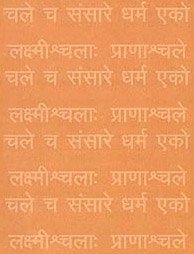Adhyaropa, Adhyāropa: 15 definitions
Introduction:
Adhyaropa means something in Buddhism, Pali, Hinduism, Sanskrit, Hindi. If you want to know the exact meaning, history, etymology or English translation of this term then check out the descriptions on this page. Add your comment or reference to a book if you want to contribute to this summary article.
Alternative spellings of this word include Adhyarop.
In Hinduism
Vedanta (school of philosophy)
Source: Google Books: The Roots of VedantaAdhyāropa is the erroneous superimposition (adhyāsa) due to avidyā (nescience), because of which, one thing is perceived as another, and the characteristics of one are attributed to the other as in the case of mistaking a piece of rope for a snake. Similarly, the characteristics of the not-Self (anātman) are superimposed on the self (Ātman), which is eternal, and of the nature of existence, consciousness and bliss, as a consequence of which, the infinite Self appears as the embodied soul (jīva) subject to the limitations of the empirical world.
Brahman, which is non-dual, appears as th wrold of plurality of insentient and sentien beings because of Adhyāropa. It is due to Adhyāropa that the Real appears as the unreal, and the unreal appears as the Real. By adopting the method of negation (apavāda), which involves discrimination, the attributes of the not-Self are eliminated to reveal the Self. Superimposition is only an appearance; therefore, the Self is unaffected by the attributes of the not-Self imposed on it.

Vedanta (वेदान्त, vedānta) refers to a school of orthodox Hindu philosophy (astika), drawing its subject-matter from the Upanishads. There are a number of sub-schools of Vedanta, however all of them expound on the basic teaching of the ultimate reality (brahman) and liberation (moksha) of the individual soul (atman).
General definition (in Hinduism)
Source: Hindupedia: HinduismAdhyāropa literally means ‘superimposition’. The attempts of reconciling Brahman-the Absolute with the world which is imperfect and limited have resulted in the ‘doctrine of adhyāropa-apavāda.’ The problem is sought to be resolved by considering the world as an adhyāropa or adhyāsa, a superimposition (as a snake is superimposed on a rope resulting in illusory perception) and denying its absolute reality.
In Buddhism
Buddhist philosophy
Source: Google Books: The Treasury of Knowledge: Book six, parts one and two (philosophy)Adhyāropa (अध्यारोप) refers to “(imaginations of) exaggeration or reification” and represents one of the ten aspects of distracting false imagination (daśa-vikṣepa-vikalpa), according to Khewang Yeshe Gyatso, Exegetical Memorandum chapter 5 (Cf. Mahāyānasūtrālaṃkārakārikā, chapter 11). These [e.g., Adhyāropa] are related to the imaginary nature (parikalpita). These ten are enumerated as aspects of false imagination which may be imputed in all sorts of contexts, and it is on this basis that the process of reification actually comes to partake of the imaginary nature.
-
Languages of India and abroad
Sanskrit dictionary
Source: DDSA: The practical Sanskrit-English dictionaryAdhyāropa (अध्यारोप).—
1) Raising, elevating &c.
2) (In Vedānta Phil.) Act of attributing falsely or through mistake; erroneously attributing the properties of one thing to another; considering through mistake a rope (which) is not really a serpent) to be serpent, or considering Brahman (which is not really the material world) to be the material world; असर्पभूतरज्जौ सर्पारोपवत्, अजगद्रूपे ब्रह्मणि जगद्रूपारोपवत्, वस्तुनि अवस्त्वारोपोऽध्यारोपः (asarpabhūtarajjau sarpāropavat, ajagadrūpe brahmaṇi jagadrūpāropavat, vastuni avastvāropo'dhyāropaḥ) Vedāntasāra.
3) Erroneous knowledge.
Derivable forms: adhyāropaḥ (अध्यारोपः).
Source: Cologne Digital Sanskrit Dictionaries: Shabda-Sagara Sanskrit-English DictionaryAdhyāropa (अध्यारोप).—m.
(-paḥ) See the next.
Source: Cologne Digital Sanskrit Dictionaries: Benfey Sanskrit-English DictionaryAdhyāropa (अध्यारोप).—i. e. adhi-ā -ruh, [Causal.] + a, m. Erroneous predication, [Vedāntasāra, (in my Chrestomathy.)] in
Adhyāropa (अध्यारोप).—[masculine] ropaṇā [feminine] transferring erroneously (ph.).
Source: Cologne Digital Sanskrit Dictionaries: Monier-Williams Sanskrit-English DictionaryAdhyāropa (अध्यारोप):—[=adhy-āropa] [from adhyā-ruh] m. (in Vedānta [philosophy]) wrong attribution, erroneous transferring of a statement from one thing to another.
Source: Cologne Digital Sanskrit Dictionaries: Goldstücker Sanskrit-English DictionaryAdhyāropa (अध्यारोप):—[tatpurusha compound] m.
(-paḥ) Fixing in or upon, transferring; but more especially used in philosophy, in the sense of transferring or attributing erroneously the predicates, nature &c. of one object to another, as those of a serpent to those of a rope &c. See adhyāsa. E. ruh, in the caus., with ā and adhi, kṛt aff. ghañ.
Source: Cologne Digital Sanskrit Dictionaries: Yates Sanskrit-English DictionaryAdhyāropa (अध्यारोप):—[adhyā+ropa] (paḥ) 1. m. Fixing upon; transferring; imputing unfairly.
Source: DDSA: Paia-sadda-mahannavo; a comprehensive Prakrit Hindi dictionary (S)Adhyāropa (अध्यारोप) in the Sanskrit language is related to the Prakrit word: Ajbhārova.
[Sanskrit to German]
Sanskrit, also spelled संस्कृतम् (saṃskṛtam), is an ancient language of India commonly seen as the grandmother of the Indo-European language family (even English!). Closely allied with Prakrit and Pali, Sanskrit is more exhaustive in both grammar and terms and has the most extensive collection of literature in the world, greatly surpassing its sister-languages Greek and Latin.
Hindi dictionary
Source: DDSA: A practical Hindi-English dictionaryAdhyāropa (अध्यारोप) [Also spelled adhyarop]:—(nm) erroneous transference of an attribute; misprojection; hence ~[paṇa] (nm); ~[pita] (a).
...
Kannada-English dictionary
Source: Alar: Kannada-English corpusAdhyārōpa (ಅಧ್ಯಾರೋಪ):—
1) [noun] act of raising, elevating, of placing over.
2) [noun] act of attributing, sometimes falsely or by mistake, the properties of one thing to the another.
3) [noun] a false perception, conception or interpretation of what one sees, where one is; erroneous knowledge.
4) [noun] an altering, enlarging or corrupting (of a book or manuscript, etc.) by inserting in new words, subject matter, etc.; interpolation.
Kannada is a Dravidian language (as opposed to the Indo-European language family) mainly spoken in the southwestern region of India.
See also (Relevant definitions)
Partial matches: Aropa.
Starts with: Adhyaropana, Adhyaropanamgey, Adhyaropanaprakarana, Adhyaropaprakarana, Adhyaropavikalpa.
Full-text: Adhyasa, Adhyaropana, Ajbharova, Attiyaropam, Adhyarop, Apavada, Vikalpa.
Relevant text
Search found 14 books and stories containing Adhyaropa, Adhyāropa, Adhy-aropa, Adhy-āropa, Adhyārōpa; (plurals include: Adhyaropas, Adhyāropas, aropas, āropas, Adhyārōpas). You can also click to the full overview containing English textual excerpts. Below are direct links for the most relevant articles:
Dvisahasri of Tembesvami (Summary and Study) (by Upadhyay Mihirkumar Sudhirbhai)
Incorporation of Vedānta in the Dvisāhasrī < [H. H. Ṭembesvāmī: Erudition]
Preceptors of Advaita (by T. M. P. Mahadevan)
Vakyapadiya of Bhartrihari (by K. A. Subramania Iyer)
Verse 2.282 < [Book 2 - Vākya-kāṇḍa]
Brihadaranyaka Upanishad (by Swāmī Mādhavānanda)
Consciousness in Gaudapada’s Mandukya-karika (by V. Sujata Raju)
The existence of mind is only from empirical (samvṛti) standpoint < [Chapter 6: A Study of Māṇḍūkya Kārikā: Alātaśānti Prakaraṇa]
Creation in the Śruti < [Chapter 5: A Study of Māṇḍūkya Kārikā: Advaita Prakaraṇa]
The teaching of non-origination (ajātivāda) < [Chapter 6: A Study of Māṇḍūkya Kārikā: Alātaśānti Prakaraṇa]
Yoga Vasistha [English], Volume 1-4 (by Vihari-Lala Mitra)
Chapter XV - The final extinction of the vidyadhara < [Book VII - Nirvana prakarana part 2 (nirvana prakarana)]
Chapter LXXXII - Yoga instructions for acquirement of the supernatural powers of anima-minuteness &c. < [Book VI - Nirvana prakarana part 1 (nirvana prakarana)]
Related products

